Chow Pressure Group (CPG)
1. Theory
Chu et al (2017) showed that there is a relationship between the magnitude of pressure interference (MPI) and the stabilized Chow Presure Group (CPG) value
The CPG calculation considers the bottomhole pressure trend before and after a well is put on production (POP). Fig. 1 shows an example of this, in which the dashed line represents the pre-POP bottomhole pressure trend. The pressure difference, \(\Delta p\), is the difference between the forecasted "prior" bottomhole pressure trend and the measured bottomhole pressure (that starts when the offset well is put on production).
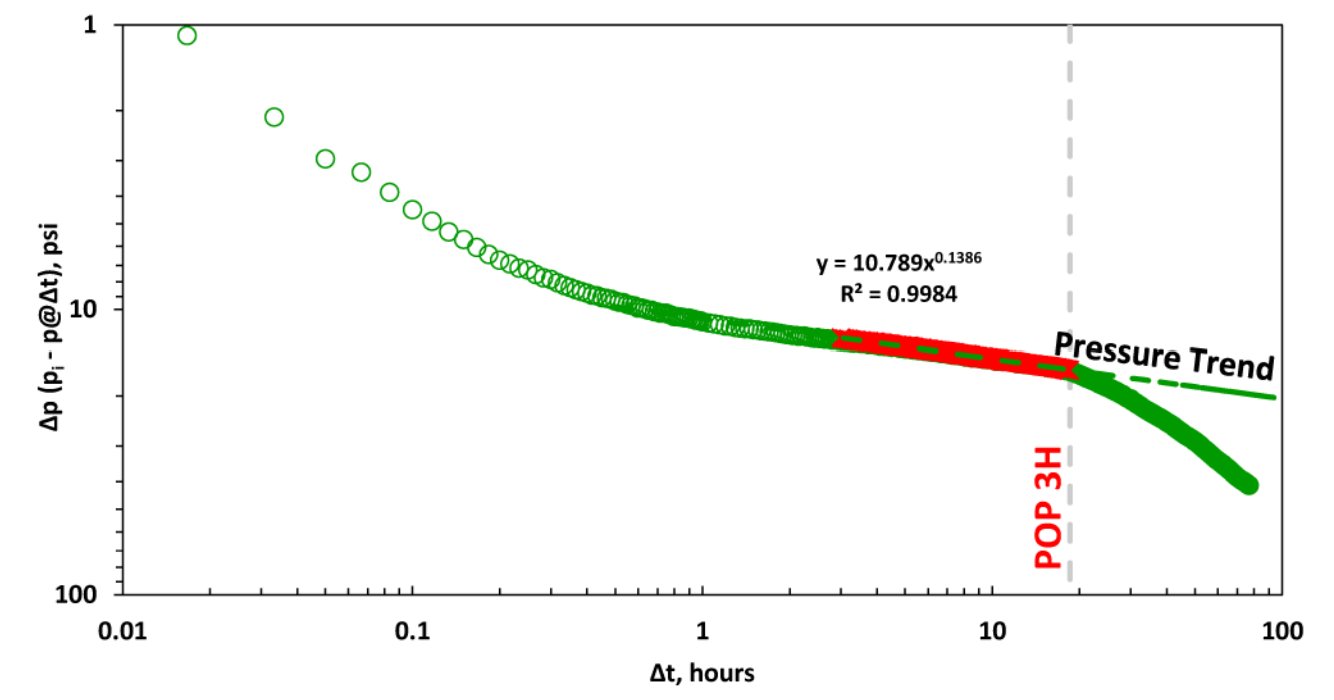
Fig. 1: Example of interference impact when offset well is put on production (POP), Chu et al (2018).
1.1 Derivative Options
The logarithmic derivative used in well testing applied directly on the \(\Delta p\) data is given by, i.e., .
There are three different ways to compute this derivative (\(\Delta p'\)) in whitson+:
- The Bourdet Derivative (Bourdet et al., 1989)
- Weighted Central Difference
- Central Difference
1.2 Bourdet Derivative (RECOMMENDED)
The Bourdet derivative is commonly used in well-test analysis (PTA) for identifying flow regimes (Lee et al., 2003) and has similarly found utility in RTA.
1.1.1 Governing Equation
To calculate the Bourdet derivative (Bourdet et al., 1989) at any given point, one point before (left) and one point after (right) is used.
1.1.2 Smoothing
The Bourdet approach is illustrated in Fig. 2 and is a way to calculate and smooth the derivative based on a log-cycle window size, L.
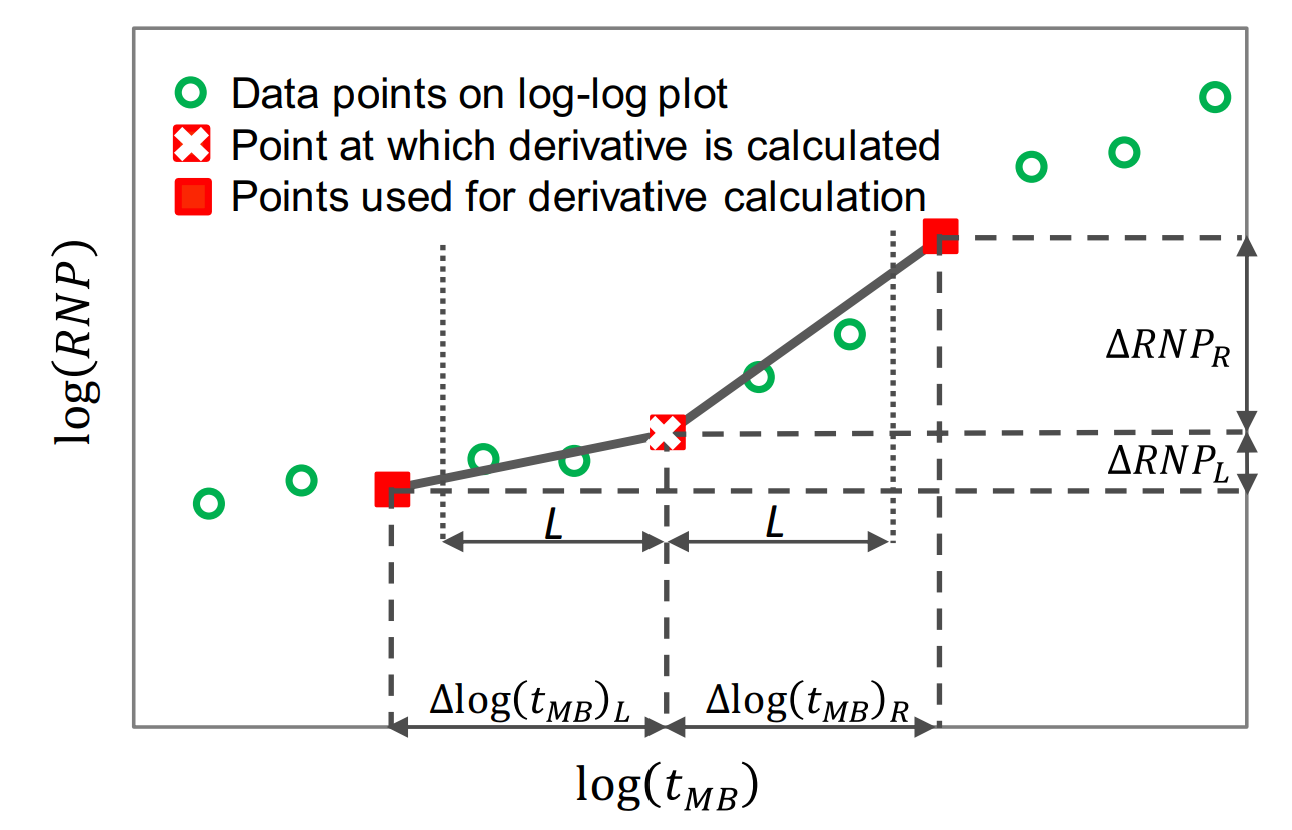
Fig. 2: Illustration of a derivative calculating using the Bourdet method. Image courtesy of Samaneh Moghadam (April, 2020). Modified from Lee et al. (2003).
It is different from a weighted central difference in the way that it uses a constant log-cycle window size, L, on both sides of the point of derivation. A weighted central difference, on the other hand, uses a constant index step size, e.g. i-5 and i+5 for step size of 5, on each side of the point of derivation. The window size, L, represents the log-cycle fraction used to control the amount of smoothing. Typical values are 0.01 to 0.2. The default L in whitson+ is 0.2. The larger the L value, the more smoothing.
The Bourdet algorithm implemented in whitson+ was provided by Behnam Zanganeh.
1.2 Weighted Central Difference
The weighted central difference is given by,
where the \(L\)-subscript refers to the index to the left with a constant step size, \(S\), i.e. \(i-S\) and the \(R\)-subscript refers to the index to the right with a constant step size, \(S\), i.e. \(i+S\).
1.3 Central Difference
This is the naive implementation, given by three points per derivative for central difference in the following manner
1.4 Leveraging the Pressure Integral
An alternative approach is to use the pressure integral as the basis to calculate the \(\Delta p\). Here, the \(\Delta p\) is rewritten as an integral as \(\Delta p_{integral}\) -
which is implemented in whitson+ as
Then, the typical well testing derivative is applied to the \(\Delta p_{integral}\) data as,
The integral method preserves the signature of the pressure plot with respect to time while significantly reducing the the noise in the derivatives. This method allows for better stabilization of the derivative values despite noisy pressure data and hence is used for more interpretability in CPG plots.
2. Level of Interference
| CPG value | Level of Interference |
|---|---|
| 0 | No pressure interference |
| 0-0.5 | Weak |
| 0.5-0.8 | Moderate |
| 0.8-1 | Strong |
How is the CPG value related to the slope in \(\Delta p\)?
The \(\Delta p\) slope fit is related to the CPG value and is a favorite way to pick stabilized CPG values as it relies on the analytical relationship between the two and avoids the use of the noisy derivative calculation from field data for an approximated answer.
The derivation of how the calculation of CPG relates to the slope of the \(\Delta p\) data, typically exhibiting power-law behavior, can be shown as follows:
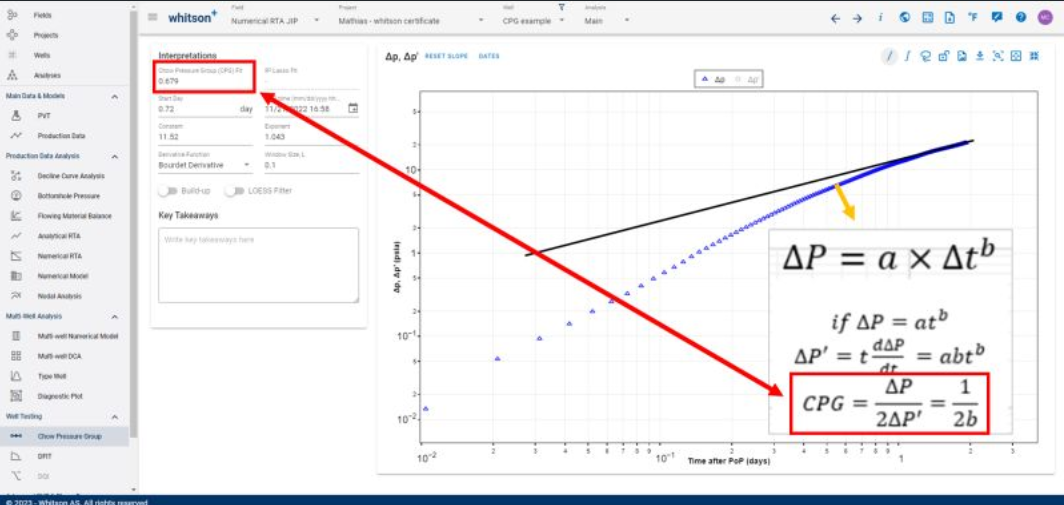
3. Data Requirements and Averaging
To perform this calculation, you only need date (time) and bottomhole pressure data. We recommend averaging the data on a 15 minute basis to remove noise in the data.
4. Example: Drawdown
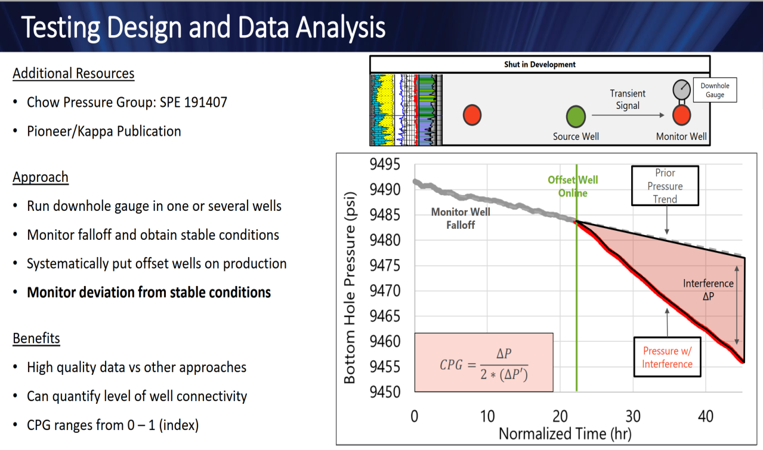
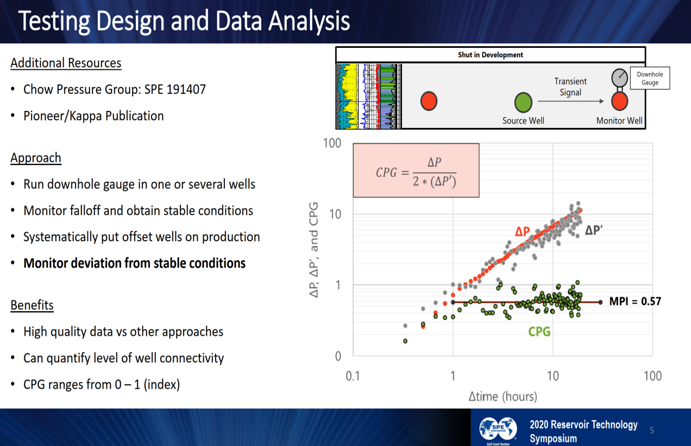
Fig. 3: Drawdown Example (Hart & Ingle, 2020)
5. Example: Buildup

Fig. 4: Drawdown Example (JPT, 2020)
Note
The Chow Pressure Group is not only a convenient way to check the slopes of log-log straight lines, but also means a identify various flow regimes. For example, the slope of 1/2 on the log-log plot may indicate a linear flow regime, which would result in a CPG of one. Likewise, the bilinear flow regime has a slope of 1/4, which would result in a CPG value of 2.
CPG Workflow
Before Getting Started
Recommended Data Size for CPG Tests
CPG datasets could be far higher frequency than needed. Datasets can vary from second by second frequency to tens of seconds for the entirety of the test. This can be harder to handle, and make the numerical derivative calculation unwieldy.
Rather than uploading high-resolution data, we recommend resampling the dataset externally using pressure increments of 5 to 10 psi. This reduces file size and improves performance. For best results, keep the number of uploaded data rows between 30,000 and 40,000. To learn how to resample your data within whitson+, see the resampling section here.
Create a Project
Here is an example dataset to try it for yourself!
Download the CPG Example Dataset here
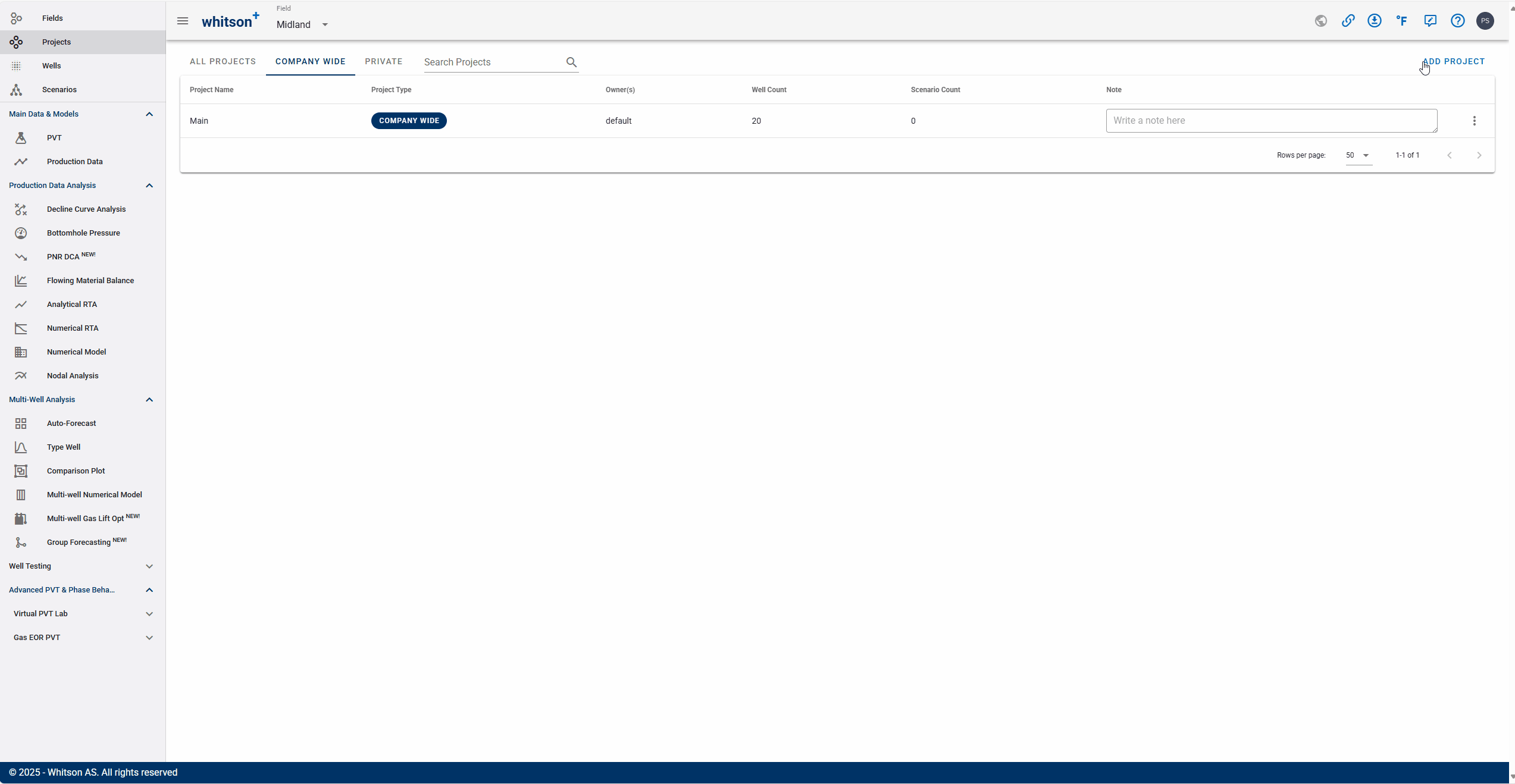
- Go to the Projects module in the navigation panel.
- Click ADD PROJECT up to the right.
- Name the project "your name - CPG Example certificate".
- Click SAVE.
- Click MASS UPLOAD up to the right.
- Upload the CPG Example Dataset Excel file.
- Click SAVE.
- All steps are shown in the .gif above.
Chow Pressure Group Analysis
You can analyze the Chow Pressure Group for the monitoring well by navigating to the Chow Pressure Group feature under Well Testing.
Pressure Difference plot

- Go to the Chow Pressure Group section in the Well Testing module in the navigation panel.
- On the Pressure Difference plot on the top-left move the CPG fit line (yellow, dashed line) to match the pressure difference data prior to the well put-on-production (POP) date.
- You can adjust the slope by:
- Manually moving the fit line on the plot (grab the line at the ends to adjust),
- Changing the Constant and Exponent of the power-law fit line directly in the input, or
- Lasso fit the pressure data prior to POP using the lasso tool to auto-adjust the fit line.
- Adjust the gray, dashed vertical line along the monitoring well data to the date and time when offset production well is POP.
- The difference in these CPG fit and the data is plotted along with it's derivative as \(\Delta p, \Delta p'\) vs. time plot (bottom-right). Observe the changes in this plot as the fit line is changed.
- All steps are shown in the .gif above.
\(\Delta p, \Delta p'\) vs. Time Plot

On the \(\Delta p, \Delta p'\) vs. time plot (bottom-right), you can switch between the derivative calculation techniques mentioned above - by selecting from the dropdown list for 'Derivative Function'.
Notice how switching between the different methods and window sizes in the GIF above changes the derivative shape and hence, impacts the CPG values calculated.
Note
Bourdet Derivative and Weighted Central Difference give you the additional option to modify the smoothing window as a log cycle fraction or a step size respectively. Both these methods are higher in accuracy compared to simply using the Central Difference with a fixed step size.
Plot Integral Function
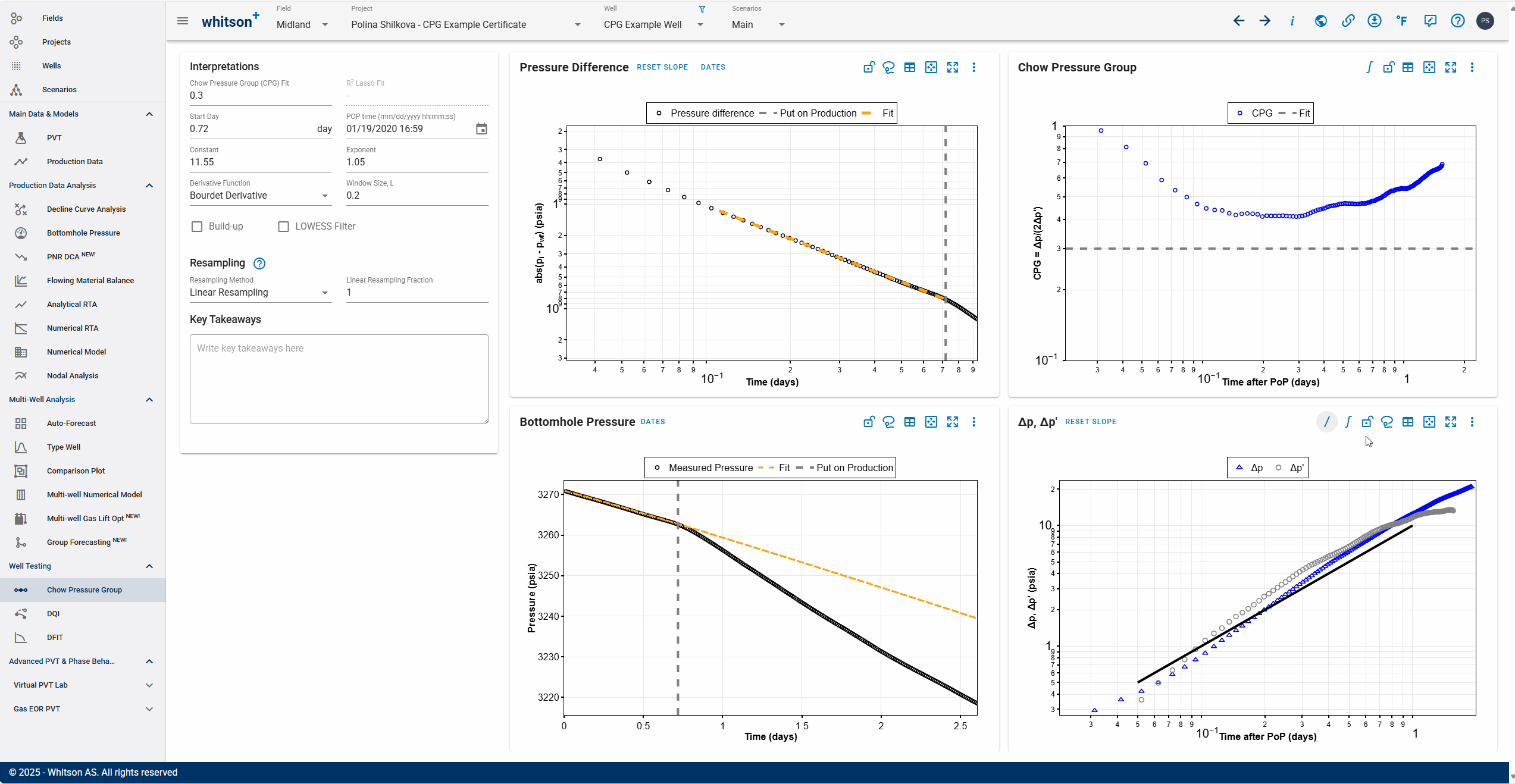
Use the integral icon Plot Integral icon in the plot options to recalculate the pressure as an integral and recompute the derivative based on the derivative function selected above. You can also use the LOWESS Filter toggle with an appropriate smoothing window in log cycles to smooth noisy pressure data.
These methods inherently smooths the pressure response, and removes additional noise that may be a part of the dataset to create a much smoother derivative and CPG plot. Since the pressure integral is already smooth, a smaller window size can be used for derivative calculation.
CPG Value

Lastly, on the Chow Pressure Group plot, you can set the final CPG value in three ways:
- Move the horizontal dashed line to track the average of the CPG values after POP date.
- You can also adjust it by entering a value for CPG fit.
- You can also select the CPG based on the slope in \(\Delta p\).
This is the CPG value that indicates the level of interference between the production well and the monitoring well.
References
[5] [Christopher R. Clarkson. Unconventional Reservoir Rate-Transient Analaysis. Volume One. Fundamentals, Analysis Methods and Workflow.]
[6] [Lee, J., Rollins, J.B., Spivey, J.P., 2003. Pressure Transient Testing. SPE, Richardson, TX.]